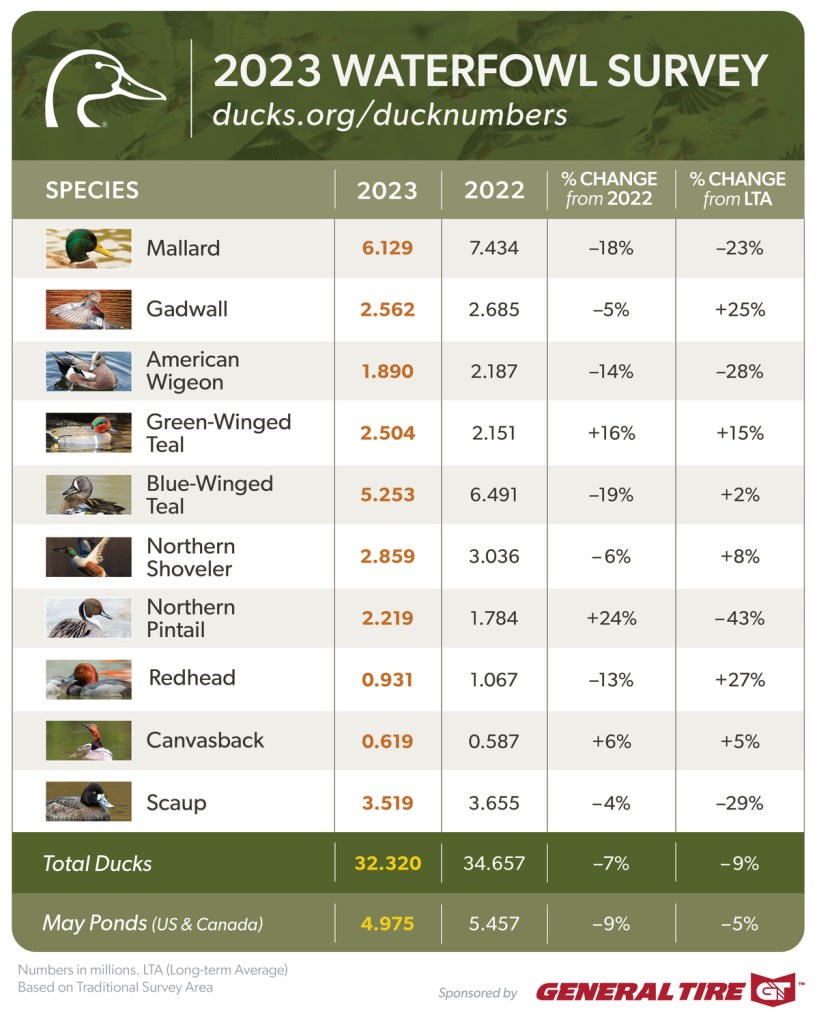Federal agency’s duck count estimates 32.3 million birds
Published 6:00 am Tuesday, September 5, 2023

- BPOP-2023 Main Survey_1080x1350.jpg
Devoted duck hunters across Acadiana, Louisiana and the rest of the country more than likely waited much of the long, hot summer for the official estimates for waterfowl numbers in the principal breeding areas of North America.
Chances are many of them might be disappointed with the U.S Fish and Wildlife Service duck population report for 2023. Overall, the total count estimates show 32.3 million breeding ducks in the traditional survey area of Alaska, Canada and north central United States, a 7 percent drop from the estimate of 34.7 million in 2022 and 9 percent below the long-term average since 1955, according to the results released recently by the federal agency.
U.S.F&WS biologists, Canadian Wildlife Service personnel and others conducted the comprehensive surveys in May and early June. They covered more than 2 million square miles by ground, airplanes and helicopters.
Dr. Steve Adair, Ducks Unlimited chief scientist, addressed the overall numbers in a prepared statement and said, “These results are somewhat disappointing, as we had hoped for better production from the prairies following improved moisture conditions in spring of 2022. Last year’s nesting season was delayed with April snowstorms and May rains, which likely impacted overall production. In the past, we have seen population growth lag moisture conditions as small, shallow wetlands recover from the lingering impacts of severe drought.”
However, according to Ducks Unlimited, “Populations of most species remain healthy and near the long-term averages, which should produce a respectable flight for waterfowl hunters for the upcoming season.”
Duck hunters may appreciate the brightest spot in the survey. There could be more pintails to shoot following the fall flight because there is a 24-percent increase in the pintail population – an estimated 1.219 in 2023 to 1.784 in 2022, a record low. However, the sobering news is the current number still is minus-43 percent below the long-term average.
Mallard and wigeon populations declined. Estimates for mallards dipped to an estimated 1.202 million, 18 percent from 2022 (1.254 million) and 23 percent from their long-term average. Estimated wigeon numbers also slipped 14 percent to an estimated 1.187 million from 2022 (1.890 million) and a whopping 28 percent below the long-term average.
With Louisiana’s special season for teal hunting right around the corner, Sept. 15-30, duck hunters may be encouraged by the fact teal numbers are over the long-term average for both green-winged teal and blue-winged teal. The U.S.F&WS survey counted an estimated 2.504 million green-wings, up 16 percent (2.151 million) from 2022 and 15 percent above the long-term average while blue-wings totaled an estimated 5,253 million, down 19 percent (6.481 million) from 2022 but 2 percent increase over the long-term average.
It’s no surprise teal already are in the Sportsman’s Paradise. Reports indicate good numbers around Welsh (south of Interstate 10) and some from Holly Beach to Kaplan, others farther to the southwest in Big Lake’s West Cove, to the southeast around Pointe-au-la-Hache (along with mottled ducks) and along the Tchefuncte River. With so many dry ponds, a genuine concern, observers are counting on a banner teal hunt at the Wax Lake Outlet.
And, apparently, there are plenty of wood ducks down here. The federal agency’s recent report also shows an 11-percent increase over the long-term average for the wood duck population, which is estimated at 1 million in the Eastern Survey Area (parts of Ontario, Quebec, Labrador, Newfoundland, Nova Scotia, Prince Edward Island, New Brunswick, and Maine), the same number as 2022.
Louisiana’s 2023-24 waterfowl hunting season begins Nov. 11 in the West Zone and Nov. 18 in the East Zone. The West Zone’s second split starts Dec. 11 and the third split opens Jan. 13 while the East Zone’s second split gets underway Dec. 16.





